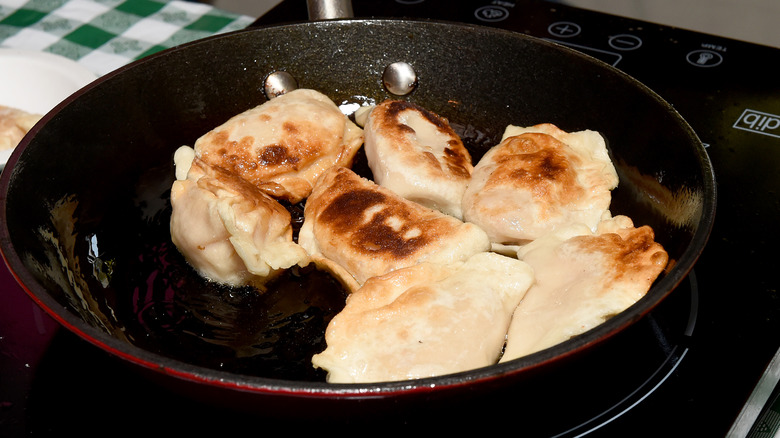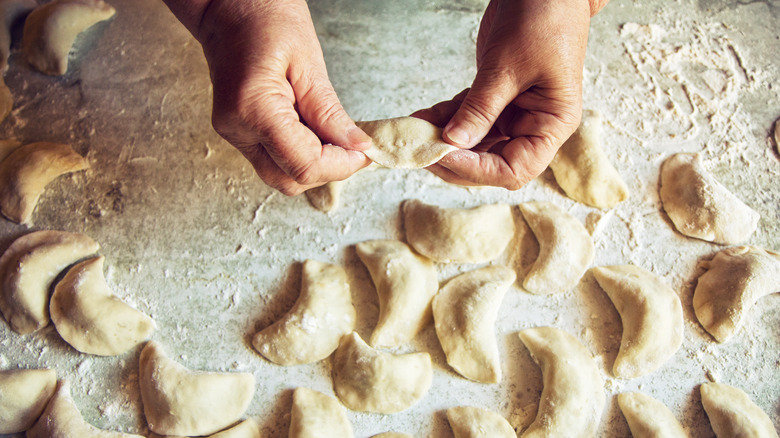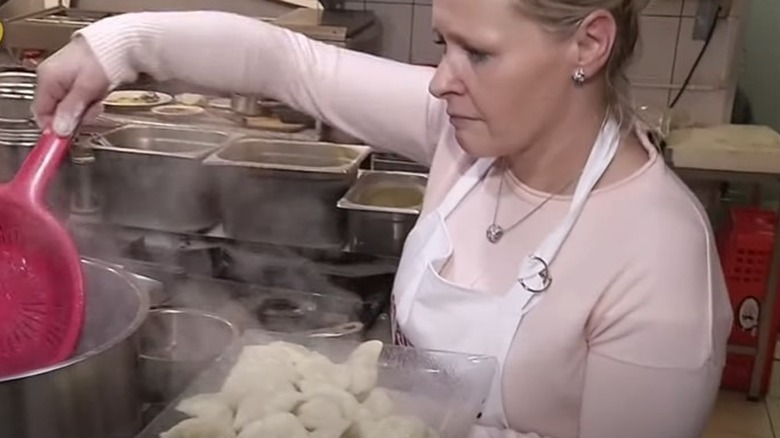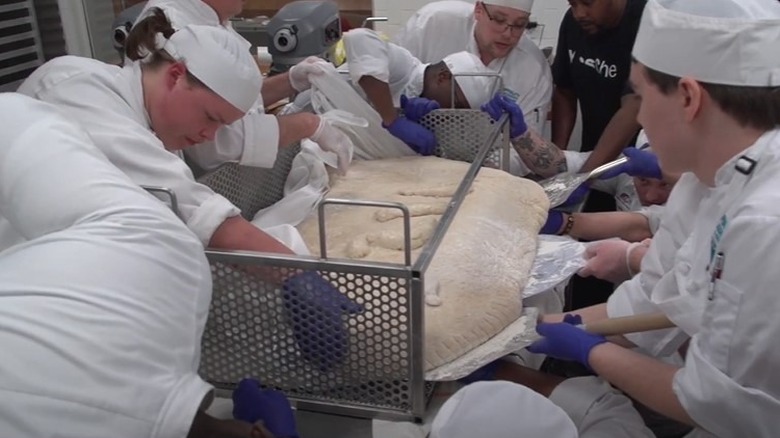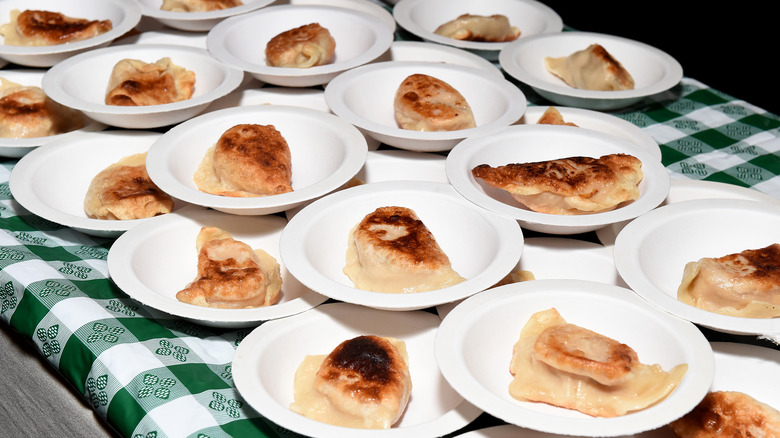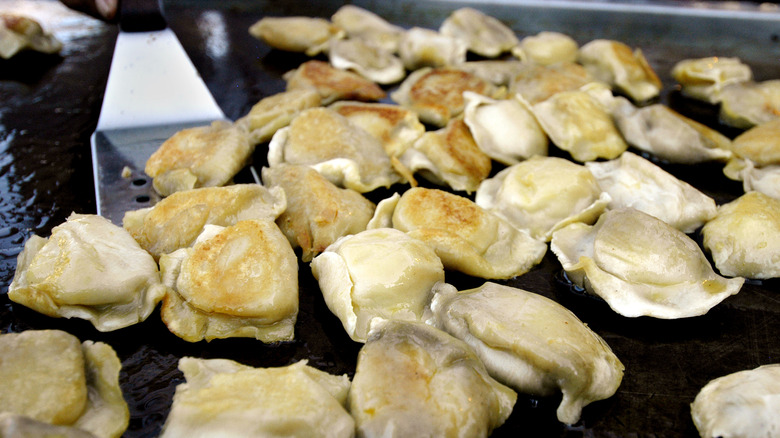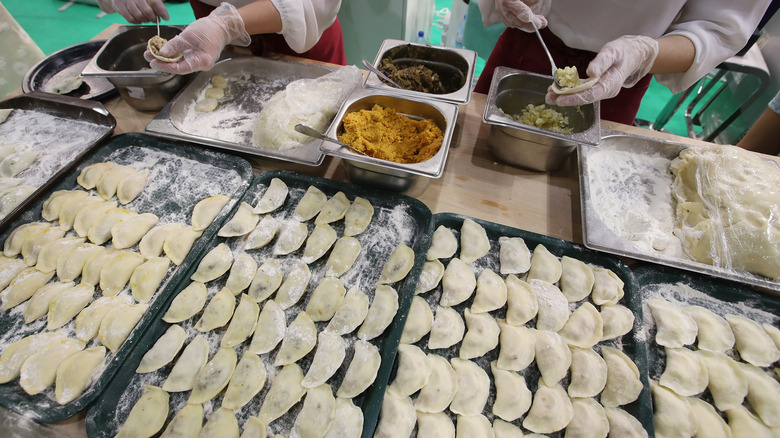The Untold Truth Of Pierogi
Perfection may be unattainable in most instances, but if one food manages to reach that impossibly high bar, it's pierogi. A beloved dumpling variety similar in appearance to ravioli or gyoza, pierogi is widely known for its intimate association with Polish cuisine. Absolutely no one, whether they're natives of Poland or immigrants and their descendants in the United States, would deny pierogi's place in the pantheon of Polish foods, alongside such culinary stars as kielbasa, bigos, and gołąbki.
The seeming simplicity of pierogi (or perogy, or however you choose to spell it) masks the utter delight lurking just beyond its crimped edges. The slightly chewy dough, stuffed with any number of fillings both savory and sweet, is an exceptionally tasty delivery system for the fantastic flavors inside. Frankly, once you've tasted pierogi, you'll understand its iconic status in Polish communities across the U.S. — including the so-called Pierogi Pocket stretching from the Midwest into the Northeast (via Cleveland.com).
We're always eager to consume as much of the Polish delicacy as we possibly can here at Mashed, whether it's actual pierogi or simply more information regarding the delectable dumpling. So let's fry up a plate of Poland's favorite dumplings (perhaps some cabbage-filled or potato-and-cheese varieties to start) and dig into the untold truth of pierogi.
The first pierogi recipe appeared in a 1682 cookbook
It's not always clear how certain foods become entrenched in a culture. This is expected, of course, given how difficult it can be to preserve information through history. It's genuinely exciting, then, when something tangible arises from the past to confirm a cultural legacy — such as the first written recipe for pierogi, found in a 17th-century Polish cookbook, "Compendium Ferculorum" (via Museum of King Jan III's Palace).
Published in 1682 by Stanisław Czerniecki, cookbook contains several recipes for pierogi, with more sweet varieties than modern diners might expect. In fact, the only savory pierogi didn't include any sort of fillings now widely enjoyed in the 21st century, like mushroom or sauerkraut. Instead, the recipe calls for veal kidneys and nutmeg (via Truly Polish).
Considering Czerniecki included recipes for both savory and dessert pierogi, it's reasonable to assume he didn't invent the dumpling for his cookbook. But as the first person to ensure the recipe for this mouth-watering food was available to the masses, we all owe the man a tip of the cap in appreciation.
Legend says the pierogi arrived in 13th century Poland
There's no disputing the fact that pierogi was first introduced to the masses in the 1682 cookbook "Compendium Ferculorum." But while author Stanisław Czerniecki is given credit for the first written pierogi recipe, he wasn't the inventor of the prized Polish food. In fact, while the precise origin is unknown, many stories trace pierogi's Polish debut back to the 13th century (via Truly Polish).
While the true story of pierogi's origin is decidedly unclear, the main reason so many in Poland believe it's existed inside the country since at least the 13th century has to do with the Polish Saint Hyacinth. In his legend, Hyacinth feeds pierogi to starving Polish villagers as early as 1240 (via The Observer).
Whether or not the story of the medieval Saint Hyacinth has any historic truth to it, most find it obvious that pierogi was already firmly entrenched in the Polish diet by the time Czerniecki published his recipe. So while the timeline of Poland's embrace of pierogi may never be known, it's clearly been a staple in the nation for quite a long time.
There's a patron saint of pierogi
Considering more than 90% of the Polish population identified as Roman Catholic as of 2016 (via Holy See Press Office), it's possible the only thing more entwined with Polish culture than the religion is pierogi. Since it's easy to see how Catholicism has played an enormous part in shaping the Eastern European country's worldview, it's no surprise the nation has many patron saints, including St. Hyacinth. Besides the country, he's also the patron saint of pierogi (via Aleteia).
It's not just the legendary story of St. Hyacinth feeding Polish villagers pierogi to fend off starvation that ties him to the food. According to The Observer, some also credit the Polish priest with the actual invention of pierogi itself. The connection between St. Hyacinth and pierogi has endured through the centuries, even spawning a Polish colloquial phrase akin to "holy cow" in the U.S.: "Swiety Jacek z pierogami," which translates to "St. Hyacinth and his pierogi."
The overwhelming homogeneity of religious belief in Poland helps explain at least some of the belief in the legend. In a country where the only thing that's arguably more popular than Catholicism is pierogi, it's only logical the food would have its own saint, too.
Almost anything can be in a pierogi
When it comes to pierogi, odds are you'd imagine a savory filling cooked inside the heavenly dough rather than sweet ingredients. But according to the Museum of King Jan III's Palace, the first published pierogi recipes were mainly of the sweet persuasion. The beauty of pierogi doesn't just come from the few tried and true varieties most people know. In fact, the subtle, unobtrusive flavor of pierogi dough means the only real limit when it comes to filling is your imagination.
This may be why, according to Tasting Poland, the key to a great pierogi is great dough. If the dough is properly prepared, it'll work with anything you put inside. Of course, while the simplicity of pierogi may give the illusion that preparing top-notch dough is elementary, the reality is that nailing the recipe takes patience and practice.
Even if you can't put together a decent dough yourself, knowing that pierogi is as versatile as it is opens up serious possibilities for your taste buds. Not unlike Taco Bell imploring consumers to think outside the bun, when it comes to pierogi, don't be afraid to consider filling options beyond potato and cheese or mushroom.
A chef made over 1,000 pierogi in an hour
If you've ever made pierogi from scratch, you understand the immense amount of work involved. Of course, as a professional can prepare any food with blazing speed compared to the average home cook, a trained chef making pierogi at a stupendous rate isn't entirely shocking. But even the most seasoned pierogi preparer has to be impressed by Beata Jasek's incredible record, where she made an eye-popping 1,066 pierogi in a single hour in 2019 (via WUSA-9).
Breaking the Guinness World Record for most pierogi made in an hour wasn't easy, though the decision seemed simple to the Polish chef. "Why not do it if it's something I'm good at?" Jasek said after accomplishing the feat at a festival in Iwkowa, Poland (via TVP World).
If you're somehow unimpressed with Jasek's world record pierogi-making feat, then we'd be willing to be you've never made pierogi yourself. As anyone who's tried can attest, it's challenging to prepare a few dozen pierogi in one hour, let alone more than 1,000.
The Pittsburgh Pirates have pierogi mascots
Though the number of Polish-Americans living in Pittsburgh has shrunk over time (via South Pittsburgh Reporter), the association between the city and Polish culture remains strong. The connection is so durable that for the past few decades, pierogi company Mrs. T's Pierogies has sponsored the Pirates Pierogies — a group of mascots for the city's Major League Baseball team, the Pittsburgh Pirates.
Since their first appearance in 1999, the Pirates Pierogies have been a favorite among the often-lackluster baseball team's fanbase (via MLB). Though the number of pierogi mascots has fluctuated, their main event — that would be competing in a 280-yard race between the 5th and 6th innings — has remained consistent.
The Pirates Pierogies don't just race, though. Instead, they've become an integral part of the entire Pirates organization. The team's Twitter has posted faux injury updates for mascots in the past (as it would for actual players), and, as of 2022, interested fans can book an appearance by any (or all) of the Pirates Pierogies on the team's website.
The largest pierogi ever made was the size of a person
It's no secret that individual portion sizes in the U.S. have increased dramatically through the decades, leading to a nation of bulging bellies. Not that this has stopped folks from pursuing bigger and bolder culinary creations, like at the Cuyahoga Community College in 2017. That year, culinary students and instructors at the Cleveland school didn't just set a world record for the largest pierogi ever made — they cooked one weighing a mind-boggling 215.5 pounds (via News 5 Cleveland).
At nearly four feet long and two feet thick, the monstrous pierogi required an intense development process before any cooking could begin (via The Villager Newspaper). A specially-designed cooking device had to be constructed to accommodate the potato-and-cheese-filled dumpling, which was displayed at the Cleveland Eats Culinary Festival before being eaten.
The culinary crew fell just shy of its stated goal of 216 pounds (meant to coincide with Cleveland's area code), but they had nothing to be ashamed about. After all, they didn't just create a pierogi that could feed an army of men; they made a pierogi that weighed more than the average adult male in the U.S. (via Healthline).
Meatless pierogi are integral to Polish Christmas Eve
The importance of traditions can't be minimized, particularly during the winter holiday season. Preserving our cherished holiday rituals helps to foster connection between generations. For many, the unparalleled significance of Christmastime includes consuming a wide swath of foods and meals. The traditional Polish Christmas Eve dinner, Wigilia, fits this bill, featuring an entirely meatless, 12-course meal that simply must include pierogi (via CT Insider).
Few cliches ring as true during the holidays as "it's not Christmas without [fill in the blank]" — and pierogi is no exception. Part of the rationale behind pierogi's holiday prevalence may be that they're difficult to make. Pierogi may be a crucial component of the holiday because the back-breaking labor involved means that it can only be made for the most special of occasions (via NPR).
While all Christmas Eve pierogi are meatless, they can differ depending on regional and familial preferences. In Poland, pierogi filled with cabbage or sauerkraut and mushrooms are quite common for Wigilia (via Culture.pl). Cabbage pierogi are also popular in the U.S. for the holiday feast, as well as potato and cheese-filled ones — the two homemade varieties this writer's Polish-American family have served on Christmas Eve for decades.
National Pierogi Day was established in 2008
Whether officially designated or not, there's no shortage of bizarre holidays on the calendar. With everything from Kiss a Ginger Day to Sword Swallowers Day celebrated throughout the year, it might be more surprising if pierogi didn't have a dedicated national day. National Pierogi Day does indeed exist on October 8, thanks to a designation and yearly celebration helmed by Mrs. T's Pierogies in 2008.
Mrs. T's Pierogies, which produced more than 550-million pierogi each year as of 2020, stylizes it National Pierogy Day, after its preferred spelling. But the semantic difference doesn't diminish the frozen pierogi company's enthusiasm for the dumpling, or its dedication to the enthusiastic celebration of all things pierogi.
The company has conducted several fan giveaways for National Pierogi Day, including a pierogi-themed clothing line in 2021 (via Fox43). Believing many were eager to "show their pierogi love on their sleeve," as Mrs. T's president, Tom Twardzik, told Fox43, the giveaway was first-come, first-serve, and included fanny packs, sweaters, and scrunchies.
American pierogi can differ from Polish ones
A food or dish evolving to coincide with shifting cultural tastes isn't uncommon. This is doubly true for foods and dishes imported to the U.S. by immigrants, where culinary tastes aren't just unique — they often vary drastically from region to region. It's entirely reasonable that the pierogi we're familiar with in the U.S. are often slightly different from those prepared back in Poland.
To be fair, the distinction between traditional pierogi in Poland and its American counterpart isn't great, but differences undoubtedly exist. For instance, in Lublin, Poland, a pierogi filled with mint, buckwheat, and lentils is common, while in the Subcarpathian Voivodeship, semolina pudding-filled pierogi is quite popular (via Culture.pl).
Regional differences in pierogi preparation don't just exist across continents, but within Poland's borders as well. Polish people living in the north out west of the country tend to believe buckwheat-filled pierogi is "slightly funny," as Jarosław Dumanowski, a historian at Nicolaus Copernicus University, told the BBC.
Making pierogi is a laborious process
If you're only familiar with Beata Jasek's lightning-quick pierogi making skills (via TVP World), you may believe that making these Polish dumplings is a breeze. The reality for us non-world record holders, though, is a far different story. In fact, preparing a batch of the dumplings from scratch is an almost interminably slow and laborious process (via BBC).
It's interesting to consider the amount of time and effort that goes into crafting pierogi. It takes mere seconds to devour one once it's served, despite the hours that may have gone into its creation. But the disproportionate ratio of time spent cooking the food to time spent eating it does little to diminish its stature in the eyes of pierogi lovers. As anyone who's made and tasted homemade pierogi will tell you, the work is worth it.
Making pierogi isn't quick or easy, but nothing worthwhile ever is. If you're still unsure whether the effort is justified, bite into a fresh-made pierogi. You'll find that it's simply paradise.
There's an enormous pierogi statue in Alberta
Not unlike Springfield trying to put itself on the map with a monorail, smaller towns and cities often take huge swings, culturally speaking, to encourage tourists to visit. These often brazen attempts to drive out-of-town interest can lead to some truly inspired creations — which is one way to describe the 27-foot tall, 6,000-pound pierogi statue in Glendon, Alberta known as Giant Perogy (via Atlas Obscura).
First unveiled in 1993, the enormous pierogi statue, which features a gigantic dumpling pierced by a likewise enormous fork, was an attempt to keep Glendon from falling into permanent economic turmoil like nearby towns in Canada. "We had to come up with something out of the ordinary to have people come in," former Glendon mayor, Johnnie Doonanco, told the CBC. After approximately two years of construction, the fiberglass and steel monument was unveiled, joining the other so-called Giants of the Prairies, roadside attractions scattered throughout rural Alberta.
As for anyone curious why the fork component of the statue was necessary, the reason is simply practical. Without the fork, designers felt the pierogi was indistinguishable from similar food items, hence its inclusion.

